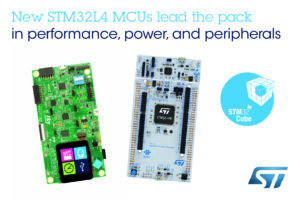 The latest STM32L496 and STM32L4A6 microcontrollers (MCU) from STMicroelectronics extend the unique fusion of ARM® Cortex®-M4F core performance and proprietary ultra-low-power technologies, adding larger memories, enhanced graphics support, extra peripherals, and increased power-saving flexibility.
The latest STM32L496 and STM32L4A6 microcontrollers (MCU) from STMicroelectronics extend the unique fusion of ARM® Cortex®-M4F core performance and proprietary ultra-low-power technologies, adding larger memories, enhanced graphics support, extra peripherals, and increased power-saving flexibility.
Bigger on-chip RAM, now up to 320 Kbytes, complements the newly added ST Chrom-ART Accelerator™ graphics engine for smoother display performance in energy-conscious applications such as IoT devices and smart watches. There is also up to 1 Mbyte Flash, an extra CAN interface, a camera interface and crystal-less Full Speed (FS) USB OTG. A new high-pin-count UFBGA169 package option gives extra flexibility to exercise these new peripherals, which join the rich digital and smart analog features shared with the STM32L476/486. The STM32L4A6 with hardware cryptographic acceleration implements SHA-256 and AES-128/192/256 algorithms.
Offering features unavailable in other ultra-low-power MCUs, the new STM32L4™ devices deliver both high core performance and outstanding ultra-low-power efficiency. The EEMBC®[1] CoreMark® score of 273 outperforms other ultra-low-power cores, while the ULPBench™ score of 217 confirms greater energy efficiency. Active-mode current of just 37µA/MHz enables longer runtime on small batteries and extends scope to create energy-neutral products powered from ambient sources.
ST has also extended the flexibility of the STM32L4 power architecture, giving developers the option to power the core from an external DC/DC converter for extra efficiency. The STM32L4 FlexPowerControl architecture includes a new shutdown mode for additional energy savings, alongside multiple independent core and peripheral supplies, and a separate VBATdomain with charging circuitry that gives flexibility to utilize or recharge battery energy. The rich selection of seven main STM32L4 low-power modes is also supported, with options such as retaining I/O levels and SRAM contents, each with several sub-modes that allow precision trimming of power consumption as application demand varies.
The new STM32L4 MCU lines arrive with extensive ecosystem support, including STM32Cube tools and software, two Nucleo-144 boards, and the STM32L496 Discovery Kit (STM32L496G-DISCO) with on-board audio/graphics features and Arduino, Pmod and STMod+™ connectivity support. The NUCLEO-L496ZG-P features an on-board DC/DC converter for powering the core directly, which allows developers to easily leverage the flexible power architecture in the most energy-conscious applications. The legacy-compatible NUCLEO-L496ZG is also available, and offers the same features as existing Nucleo-144 boards.
Budgetary pricing is from $4.63 for the STM32L496RET6 with 512 Kbytes Flash and 320 Kbytes SRAM in LQFP64 package, for orders of 10,000 pieces per year.

Leave a Reply